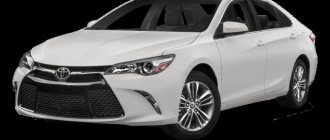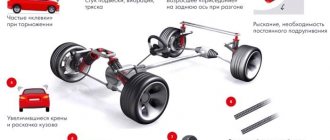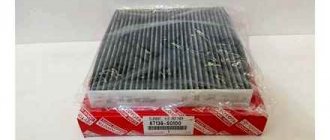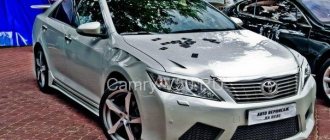Among owners and potential buyers, disputes periodically arise about the degree of prestige of Toyota Camry cars and what class the cars should be classified into. There are several classification systems with different criteria. According to the standards of the European Union, the equipment belongs to category E (the standard takes into account the dimensions of the body), and Euro NCAP classifies it as class D.
Toyota Camry is the best-selling car in the United States.
Varieties of car classes
There are several standards for classifying cars:
- In the USSR, since 1966, the industry standard OH 025270-66 was in force, which provided for gradation by dry weight and engine displacement. Within classes there were groups that made it possible to further divide equipment into types. Industry standards were used when forming the model code; with the collapse of the USSR, the standard continued to be used in Russia and some former republics.
- The North American standard takes into account interior volume. The standard provides for division for cars with station wagons (Small, Mid-size or Large station wagon), as well as for SUVs (Compact, Mid-size and Full-size). Until the beginning of the 80s. The length of the wheelbase was taken into account, but due to the constant reduction of the parameter, it was decided to switch to a gradation based on interior capacity.
- EuroNCAP rules divide vehicles by weight and dimensions for comparative analyzes of crash test results. There are groups for small sedans (for example, Renault Logan), full-size cars, city cars, crossovers and minivans.
- National requirements (eg France or Spain) that take engine power into account when calculating the tax rate.
- Japanese standard for the domestic market, dividing cars into 3 groups based on body dimensions. The legislation of this country taxes cars depending on the length of the body.
- China uses a hybrid scheme that combines features of Japanese and European standards. When dividing into classes, body length, engine size and the number of rows of seats in the cabin are taken into account.
- The Economic Commission for Europe standard provides for the division of equipment into 9 categories, designated by letters of the Latin alphabet (for example, mini-class A, segment J is allocated for SUVs). It is allowed to introduce transitional categories (B+, C+, etc.). The standard has become the most widespread in the world. Below we discuss the features of vehicle classes according to European Union standards.
There is no direct relationship between the classifications. For example, the compact hatchback Volkswagen up! corresponds to European category A and meets Russian requirements for city cars. According to the Euro NCAP standard, the equipment belongs to the Supermini category, and according to American standards it corresponds to a Subcompact car. Having increased dimensions, the Volkswagen Polo is category B (small class according to Russian standards and Supermini or Subcompact car according to Euro NCAP and US standards, respectively).
A (mini cars)
The category includes small-sized cars intended for use in urban environments (periodic trips to highways are allowed). The equipment allows you to transport people and small-sized cargo. Body length no more than 3600 mm with a width of up to 1600 mm. Cars are most often equipped with hatchback bodies with 3 or 5 doors. Classic representatives are the Peugeot 107 or KIA Picanto. The small-sized Smart Fortwo also falls into group A, but corresponds to a motorized stroller according to Russian standards.
The KIA Picanto is designed for use in urban environments.
B (small cars)
The category is distinguished by a length increased to 3900 mm and a width of up to 1700 mm, excluding mirrors. Restrictions led to the use of hatchback bodies with front-wheel drive and a transverse engine. Representatives of the segment are Volkswagen Polo or Ford Fusion; compact sedans (for example, KIA Rio) have become widespread on the Russian market.
European categories A and B correspond to the American Mini (up to 85 cubic feet) and subcompact (up to 99.9 cubic feet) classes.
C (medium cars)
Category C or golf class allows a body length (sedan, station wagon or hatchback) of up to 4300 mm with a width of 1700 to 1800 mm. The group includes Toyota Corolla, VW Golf, KIA Ceed or Peugeot 308 cars with front drive wheels. There are models with all-wheel drive - for example, Skoda Octavia 4x4. The group corresponds to an American compact car with interior volume ranging from 100 to 109.9 cubic feet.
Skoda Octavia belongs to the golf class.
D (larger cars)
The middle category includes cars with sedan or hatchback bodies with a total length of no more than 4600 mm. The cars are distinguished by increased interior capacity and larger luggage compartments. Representatives are Ford Mondeo, Peugeot 408 or BMW 3 Series.
In the US market, Groups D and E correspond to mid-size cars with interior volume of 110-119.9 cubic feet.
E (executive)
The highest category of the middle group or business class, is distinguished by an elongated body (more than 4600 mm) and increased comfort. Representatives are 4-door sedans or station wagons (some manufacturers offer vehicles with additional space for transporting cargo) Audi A6, Toyota Camry or BMW 5 Series.
Toyota Camry is a business class car.
F (luxury)
The luxury group includes cars with sedan bodies longer than 5050 mm, characterized by a spacious interior and increased comfort. Classic representatives of the category are the BMW 7 Series, Mercedes-Benz S-Class, Audi A8. The American standard classifies equipment as full-size cars.
Additional groups
The European classification provides several categories for all-wheel drive vehicles and sports cars:
- S - assigned to sports cars (for example, Ferrari, Lotus, Lamborghini) without taking into account dimensions, interior capacity or cylinder displacement;
- M - designed for commercial trucks, vans or minibuses (for example, Mercedes-Benz Sprinter);
- J - assigned to off-road vehicles (for example, Toyota Land Cruiser).
Toyota Camry class depending on year of manufacture
During the production process, Camry cars were equipped with bodies that differ in size and internal volume. The dimensions of the equipment never fell below the level corresponding to category D. Marketers of the Japanese concern always indicated class E for Camry sedans or station wagons (similar to the premium segment of the Lexus GS), which was the subject of criticism from automotive experts.
XV10
The Camry XV10 generation began production in 1991 for the Japanese domestic market and belonged to the Small size vehicles category (body length up to 4700 mm). In 1993, the company introduced the model to foreign markets (the body differed in size and shape from the Japanese version); in the United States it was classified as a mid-size car. According to European requirements, the car was between groups D and E, but automobile magazines and catalogs classified the Camry XV10 as class D.
Toyota Camry XV10 is a car with a 5-speed gearbox.
XV20
Introduced in August 1996, the XV20 generation had sedan and station wagon body styles. For some markets, long-wheelbase sedan and 2-door coupe versions were offered. Toyota declared compliance with group E, but in Europe the car was assigned category D, and in the USA the equipment was classified as a mid-size vehicle.
Toyota Camry XV20 is the fourth generation of the famous Japanese sedan.
The Camry Solara version with a coupe body with a sporty twist, produced by the Canadian branch of the concern, was also considered a passenger car with medium dimensions.
XV30
In 2001, a new generation of the Camry XV30 was introduced, which did not provide any other bodies other than a 4-door sedan with a length of 4815 mm. The increase in dimensions made it possible to achieve class E compliance, but many automobile publications criticized the equipment for an insufficient level of comfort and equipment that did not correspond to European concepts of business-class cars. The XV30 generation was the last to be offered on the European market; further models were sold in North America, Russia, Southeast Asia and Arab countries.
Toyota Camry XV30 is a 4-door car.
XV40
The XV40 generation, which appeared in 2006, had a body length of 4815 mm, which made it possible to fit into the European framework of category E. The cars were supplied to Russian customers as representatives of the business class, but in terms of equipment and dynamic characteristics, Toyota products were inferior to competitors from Europe (for example, Mercedes- Benz or BMW). The advantage of Japanese cars was the reduced price, which made it possible to occupy a large part of the niche in the Russian market.
Toyota Camry XV40 is a popular Japanese business class sedan.
The deep modernization carried out allowed the production of the new XV50 body to begin in 2012, which underwent restyling in 2014 (the model code changed to XV55). The length of the car for Russia was 4820 mm; for the markets of North America and Southeast Asia, a body with modified bumpers was offered, increasing the dimensions by 30 mm. The vehicle was positioned as a business class sedan, corresponding to category E according to the European rating scale and medium size according to the North American standard.
XV70
In 2021, the production of the XV70 generation started with a sedan body having a length of 4885 mm and a width of 1840 mm. In the US market, the car meets the requirements for medium-sized cars. By European standards, the equipment belongs to category E, but due to the emergence of additional gradations between the main classes, it meets the requirements of E+.
Toyota Camry XV70 is a sales leader, a successful and reliable car.
Reviews from car owners
Evgeniy, 43 years old, Murmansk
I purchased a Camry in the XV20 body at the beginning of 2021. I needed a simple and inexpensive car with a cabin that could accommodate up to 5 passengers. The declared mileage was 560 thousand km, the 2.2 liter engine was consuming oil, so it was necessary to replace the valve caps and install new piston rings (no cylinder boring was required). The car has covered 40 thousand km after repair, routine maintenance is carried out every 10 thousand km. There are scuffs on the seats and door panels, the plastic in the interior creaks in cold weather (the car is 24 years old).
Konstantin, 35 years old, Tula
I was the owner of Camry 20 for 4 years. The car was equipped with a 3.0-liter engine with an upgraded control program. On straight sections of the highway, the car accelerated to 220-230 km/h according to the speedometer, but the body began to sway. The sills and fenders had chips and surface rust that did not go under the paintwork. During my ownership I carried out regular maintenance, I had to change the power steering pump and rebuild the rear suspension. I sold the car to a relative in 2015 with a mileage of 430 thousand km, the person still uses the car today.
What class of cars does Toyota Camry belong to?
Since the beginning of the 2010s. There was a gradual increase in vehicle dimensions, which led to the emergence in 2013 of intermediate categories between groups D, E and F, which are designated by the symbol +. In accordance with the new system, category D+ includes cars with a body length ranging from 4600 to 4850 mm. All Toyota Camrys released before 2021 comply with class D+, but the XV70 generation, by increasing its dimensions to 4885 mm, meets the requirements of the E+ standard (length from 4850 to 5050 mm).
There is an additional gradation of cars according to the level of comfort into premium, medium and budget segments, each of which is divided into categories according to the European or American scale. The Toyota Camry sedan corresponds to the middle segment; for the premium class, the Toyota concern has a separate Lexus brand, under which the ES model is offered.
Advantages and disadvantages
Advantages:
- soft and spacious interior;
- low level of noise and vibration;
- spacious trunk;
- ease of repair.
Flaws:
- large runs of surviving specimens;
- corrosion of body elements;
- high fuel consumption;
- problems with purchasing original spare parts.











